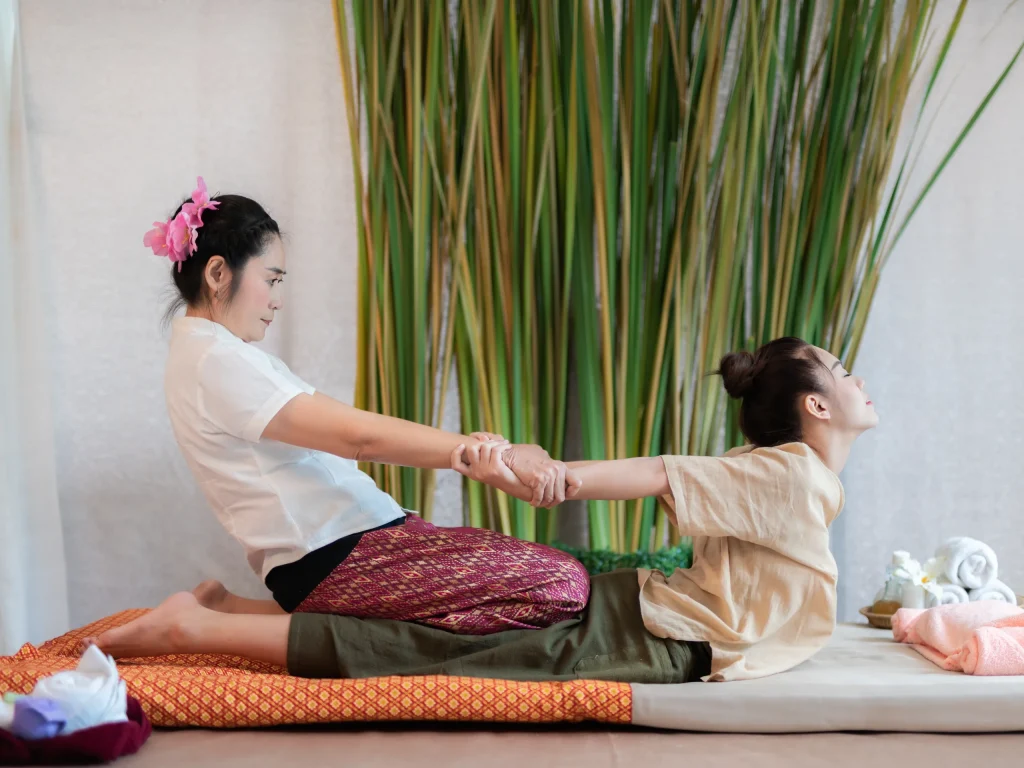How Often Should You Get a Thai Massage to See Improvements in Flexibility?
To see noticeable improvements in your flexibility, start with one to two Thai massage sessions per week. This frequency helps stretch and elongate your muscles and tendons effectively. As your body adjusts, you can reduce sessions to every two to three weeks to maintain your progress. Athletes or those with high physical activity might benefit from more frequent sessions. Personalize your plan based on your individual flexibility goals and lifestyle needs. By tracking your progress, you’ll notice enhancements in your range of motion and overall well-being. Curious about more detailed recommendations and techniques? Keep exploring!
Understanding Thai Massage
A Thai massage combines acupressure, Indian Ayurvedic principles, and assisted yoga postures to create a unique therapeutic experience. You might be curious about the massage’s history and how its traditional techniques have evolved.
Originating over 2,500 years ago in Thailand, this practice has roots in ancient healing methods passed down through generations. It’s often attributed to Shivago Komarpaj, the Buddha’s physician, who blended Ayurvedic techniques with knowledge from Chinese medicine.
When you experience a Thai massage, you’re engaging in a tradition that values the body’s energy lines, known as ‘Sen.’ Practitioners apply rhythmic pressure along these lines using their hands, elbows, knees, and feet. They also incorporate stretching and assisted yoga postures to enhance your body’s natural flow of energy. If you’re curious about Thai massage Edinburgh prices, you’ll find they vary depending on the length and type of service you choose.
Traditional techniques are meticulously designed to relieve muscle tension, improve circulation, and promote relaxation. Unlike other forms of massage that focus on kneading muscles, Thai massage emphasizes the alignment of the body’s energy pathways. This holistic approach not only addresses physical discomfort but also aims to balance your mind and spirit.
Flexibility Benefits
When you get a Thai massage, you’ll notice an enhanced range of motion and improved joint mobility.
The therapist uses muscle relaxation techniques that help alleviate tension and increase flexibility.
Regular sessions can make a significant difference in how freely you move.
Enhanced Range of Motion
Getting regular Thai massages can greatly enhance your range of motion by loosening tight muscles and improving flexibility. One significant way this happens is through the stretching exercises incorporated into the massage techniques. These stretches are similar to those found in yoga, making Thai massage an excellent complement to yoga practice.
By integrating yoga principles, Thai massage helps elongate your muscles and tendons, allowing for a more extensive range of motion.
 When you receive a Thai massage, the therapist will guide your body through a series of stretches and positions. This process helps break down muscle stiffness and promotes greater flexibility in your joints. Over time, these stretching exercises can lead to noticeable improvements in how easily you move and perform physical activities.
When you receive a Thai massage, the therapist will guide your body through a series of stretches and positions. This process helps break down muscle stiffness and promotes greater flexibility in your joints. Over time, these stretching exercises can lead to noticeable improvements in how easily you move and perform physical activities.
Incorporating Thai massage into your routine can also help you achieve yoga poses that once seemed difficult. The enhanced range of motion allows you to stretch deeper and hold poses longer, maximizing the benefits of your yoga practice.
Muscle Relaxation Techniques
As you work on enhancing your range of motion, incorporating muscle relaxation techniques in Thai massage can greatly boost your flexibility. Thai massage combines deep stretching exercises with specific muscle relaxation methods to release tension and improve overall flexibility. By focusing on these techniques, you can achieve more effective results from your massage sessions.
To get the most out of your Thai massage, consider these key muscle relaxation techniques:
- Active Stretching: This involves moving your muscles through their full range of motion, which helps lengthen and relax them.
- Static Stretching: Holding a stretch for an extended period can notably improve muscle flexibility and relaxation.
- Breathing Techniques: Deep, controlled breathing during the massage helps calm your nervous system, allowing your muscles to relax more fully.
- Pressure Point Therapy: Applying pressure to specific points on your body can release muscle knots and improve overall muscle relaxation.
Joint Mobility Improvement
You’ll find that regular Thai massage sessions can greatly enhance your joint mobility and overall flexibility. By incorporating stretching and pressure techniques, these massages improve the circulation of synovial fluid, which is essential for joint lubrication. This fluid acts as a lubricant for your joints, reducing friction and allowing for smoother, more flexible movements.
Thai massage also targets the connective tissues around your joints. The stretching involved helps elongate these tissues, making your joints more supple and less prone to stiffness. When your joints are well-lubricated and your connective tissues are flexible, you experience an increased range of motion and greater ease in your daily activities.
Moreover, the rhythmic movements and stretches in a Thai massage can boost the production of synovial fluid. This not only enhances joint lubrication but also nourishes the cartilage, keeping your joints healthy and reducing the risk of degenerative conditions like arthritis.
Initial Assessment
Before starting your Thai massage routine, you’ll need an initial assessment to evaluate your body’s condition. This assessment will measure your flexibility baseline and help craft a personalized treatment plan. By conducting this, you can guarantee that the sessions address your specific needs and goals.
Having a clear understanding of your body’s current state is essential for tailoring the massage techniques to provide the most effective results. The initial assessment sets the foundation for a successful and beneficial Thai massage experience.
Body Condition Evaluation
To determine how often you should get a Thai massage, it’s important to start with a thorough body condition evaluation. This initial assessment allows you to understand your current physical state and helps tailor the massage sessions to your specific needs. Here’s what you should focus on:
- Body Posture: Evaluate your body posture to identify any imbalances or misalignments. Poor posture can contribute to muscle tension and reduced flexibility, making it vital to address these issues early on.
- Muscle Tension: Identify areas where you feel chronic muscle tension or stiffness. Thai massage techniques can target these spots for relief and improved flexibility.
- Range of Motion: Assess your current range of motion in various joints. Limited movement in certain areas can indicate where you need more focused attention during your sessions.
- Holistic Healing Needs: Consider your overall well-being and any stress or emotional factors impacting your physical condition. Thai massage promotes holistic healing, addressing both physical and mental aspects.
Flexibility Baseline Measurement
After evaluating your body condition, the next step involves measuring your flexibility to establish a baseline for your Thai massage sessions. Start by performing simple stretching routines that target various muscle groups. This helps you identify your current flexibility benchmarks, which are important for tracking your progress over time.
To measure flexibility, you can use common tests like the sit-and-reach or shoulder flexibility test. For the sit-and-reach, sit on the floor with your legs straight and reach forward as far as you can. Note the distance you reach. For the shoulder flexibility test, try to touch your hands behind your back, one over the shoulder and one under. These assessments give you a clear picture of your starting point.
Record your results in a journal or app, noting any areas of tightness or discomfort. These notes will be essential for tailoring your future stretching routines and Thai massage sessions. By establishing these flexibility benchmarks, you’ll be able to set realistic goals and see tangible improvements as you continue with your Thai massages.
Tracking your progress helps you get the most out of your sessions and identifies which areas need more focus.
Personalized Treatment Plan
During your initial assessment, the therapist will evaluate your flexibility benchmarks and discuss your specific needs to create a personalized treatment plan. They’ll take into account your individual preferences to make sure the sessions are both effective and enjoyable for you. This isn’t a one-size-fits-all approach; your plan will be tailored through treatment customization to target your unique areas of concern.
Here’s what typically happens during the initial assessment:
- Flexibility Tests: You’ll go through a series of movements to assess your current range of motion.
- Medical History: The therapist will review any past injuries or conditions that could impact your flexibility.
- Goal Setting: You’ll discuss what you hope to achieve, whether it’s improving overall flexibility, targeting specific areas, or enhancing athletic performance.
- Session Frequency: Based on your goals and current flexibility, the therapist will recommend how often you should get a Thai massage.
Your individual preferences are essential for treatment customization, making certain that each session aligns with your comfort level and targets your specific needs. By considering all these factors, the therapist can develop a plan that maximizes your flexibility improvements over time.
